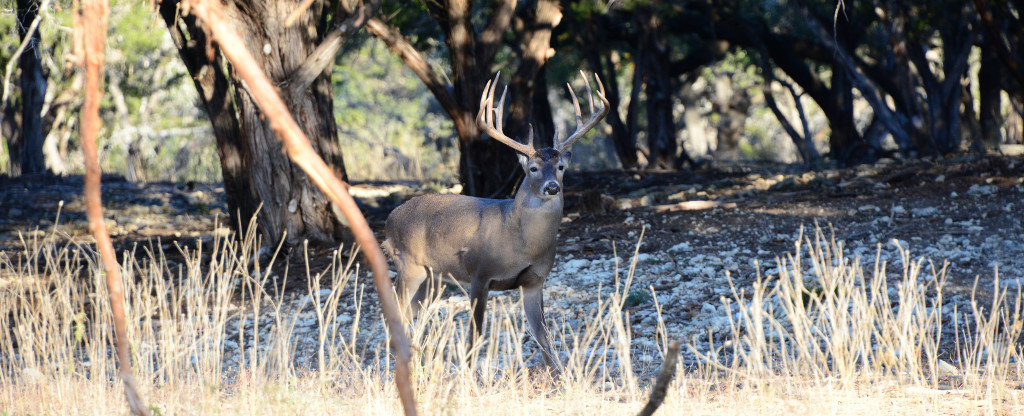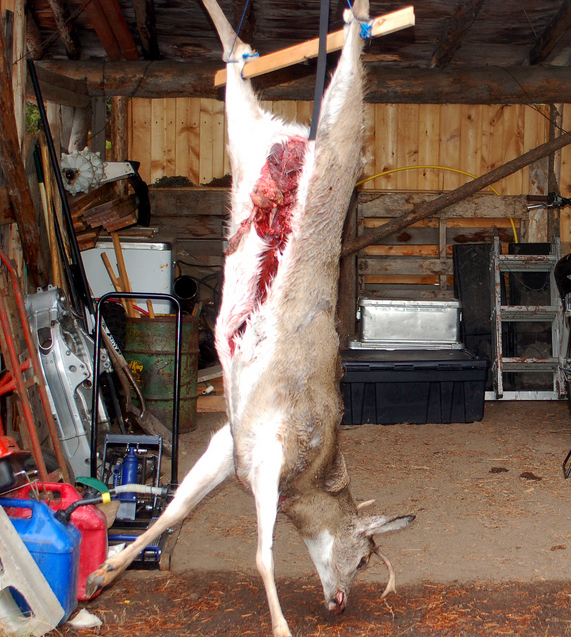A wild turkey presents a challenge to hunters. Despite becoming quite large, they are wily birds with protective coloration that allows them to blend into the background with ease. Bagging one can be both fun and arduous. Once the hunter brings down the turkey, the question they will need to ask is, “What next?” Bagging the bird is only part of the process. It then needs to be field dressed and cleaned, so it can be destined for the dinner table. Learning how to clean a turkey isn't difficult, though.

Turkey Cleaning Knives
Before you even begin, make sure that your knives are sharp. Sharp knives cut whereas dull knives tear. Dull knives are also more dangerous because the blade is more apt to slip rather than cutting through the flesh of the turkey. There is nothing at all wrong with making sure that the knives are sharp and ready, along with a sturdy cutting board, before even going into the field for a wild turkey. That way you'll be prepared when you bag one.
Field Dressing vs Cleaning
It should be recognized that field dressing a wild turkey isn’t the same thing as cleaning a wild turkey. Field dressing is specifically what is done in the field after killing the turkey and before transporting it home, where it can be cleaned. Some hunters don’t even bother with field dressing, particularly if they aren’t far from home. However, as with all game, including game birds, doing at least some field dressing usually results in a better tasting bird. Field dressing also facilitates later cleaning of the turkey.
There isn’t a great deal to do when field dressing a turkey. The idea behind field dressing a turkey is to keep the bird as free of dirt, grass and other debris as possible. Some hunters will gut the bird right on the spot. This isn’t a bad idea since the bird will still be warm, but gutting will be covered in the section on cleaning. Technically, gutting is part of the cleaning process. However, the faster the turkey is cleaned and the meat is chilled, the better the flavor normally is.
In the field, any dirt, leaves, needles or grass should be removed, especially that sticking to any blood from the wound or wounds that resulted from bringing down the turkey. The head and feet can can also be removed at this time, but again this is part of cleaning. It also usually produces more bloody feathers that dirt can stick to. When removing the blood and debris, it is a substantial time saver if you make an effort to keep feathers from sticking to the meat.
Once the bird has been field dressed, it needs to be transported to the car, camp or home without allowing the turkey to pick up more dirt and debris. There are devices that are made specifically for this, such as the Gerber Turkey Sling Carrier. These devices attach to the feet and allows a hunter to carry the bird over his or her shoulder.
In a pinch, a hunter can use some rope or even a heavy bag, but the idea is to not let the turkey drag against the ground, bushes or trees. It should also be remembered that it isn’t at all uncommon to bag wild turkeys that are in excess of 20 pounds, so whatever device is used must be able to hold a bird of this size.
Plucking a Wild Turkey
Once the wild turkey has been transported home or to wherever the turkey is going to be processed, the next step is to pluck it. Some hunters prefer to gut the bird first, however this increases the likelihood of getting feathers and debris inside of the bird, which can contaminate the meat, giving it a stronger taste. Thus, plucking is recommended prior to gutting.
There are two main ways to remove the feathers of a wild turkey.
Method #1: Plucking
The first way is to pull out the feathers, a few at a time. Care must be taken with this method not to tear the skin. The turkey can be dipped briefly in boiling water to loosen the feathers, making this an easier task, but the smell that this produces isn’t very pleasant.
The preferred sequence for removing the feathers if the turkey is plucked is to remove those from the breast, belly and back first, then those of the legs and finally remove the feathers of the wings. The feathers of the wings, especially the primary flight feathers, tend to be securely attached, so it might be necessary to use a pair of pliers to remove them.
When pulling out the feathers, make sure that the pin feathers are also removed. These are small feathers that are quite close to the skin. The pin feathers can either be pulled out or singed off, using a candle or a blow torch. Singeing won't remove all of the feather and it also stinks, so pulling is the better option.
Although plucking can be time consuming, assuming that the hunter doesn’t often pluck birds, however, with care, the result can look very much like the raw turkeys that can be purchased in a grocery store.
Method #2: Skinning
Skinning the wild turkey is easily the simplest way to remove the feathers and you don’t have to contend with the smell of wet feathers or singed ones. It is also the fastest way to remove the feathers, normally.
To skin the turkey, remove and discard the head, take off the feet at the knee joint and cut through the last joint of the wing, discarding the part that has the primary feathers.
Next, grasp a large handful of feathers and pull off the feathers and skin. There is no need to be careful of ripping the skin, because that is precisely what you want to do anyway. Keep removing the skin until none remains on the bird.
Cleaning the Turkey
Notice the operative word; clean. Throughout the entire process from bagging the bird to eating it, it is in your best interest to keep knives, cutting board, the sink, your hands and anything else that is used to clean the turkey as clean as possible. With that in mind, we can move on to how to clean a turkey step by step.
Step #1: Remove the Oil Gland
Begin by placing the turkey on its breast so you can get to its back. Carefully cut out the oil gland that is located at the base of the back, just above where the tail connects. This marble sized gland contains the oil that the living turkey uses to waterproof its feathers. If it isn’t removed, the turkey is likely going to taste oily when it is cooked.
Step #2: Get Rid of Head and Feet
If it hasn't been done by this point, remove the head of the bird, both feet at what seems to be the ‘knee’ (it is actually the ankle) and the last joint in the wings. These can be discarded. Although this can be done with a very sharp knife, exercising extreme caution, it can be a little easier to simply chop them off, using a sharpened hatchet and a cutting block.
Step #3: Remove the Windpipe
Turn the turkey over onto its back and if the membrane at the base of the neck and connecting to the top of the breast is still intact, cut it free and remove it. Do this carefully so that the craw isn’t punctured. The craw is a sack that holds the grain and other food the turkey was eating until it can pass through the gizzard and ground up. If the craw is punctured, the material inside of it can be later rinsed away, but the process is simplified if it isn’t punctured in the first place and there is less chance of tainting the meat.
This should give you access to the tough windpipe that runs down the underside of the neck. This needs to be removed completely. Leaving the windpipe in can lead to the meat becoming tainted and picking up a disagreeable gamy flavor, so the windpipe should be removed as quickly in the cleaning process as possible. It is even better if it is removed during field dressing, if this can be done without getting feathers and debris on the meat of the bird.
Step #4: Remove the Entrails
The next step is to gut the wild turkey. Do this by cutting carefully between the tail and the anus, then cut all the way around the cavity formed by the base of the breast bone and ribs. Again, don’t cut deeply or you can puncture the intestines. Be prepared for a stench, because this is stinky work even if the intestines aren’t punctured.
Once the cut has been made all the way around, reach inside the turkey and pull out the guts and all the organs from one end of the bird to the other. This will include the liver, heart and gizzard. All three of these can be retained for later use, but you will want to cut loose any veins or connective tissue and in the case of the gizzard, cut it open so you can wash out the grit and other contents. Rinse the heart, liver and gizzard thoroughly, then set them aside in a bowl of water. Discard all the other innards.
Step #5: Wash Out the Turkey
Rinse the carcass under running water to remove any blood, blood clots, remnants of guts and any other debris that might have found its way onto or inside of the bird. This is also a good time to check for any feathers that might be sticking to the carcass. It is a good idea to take your time when doing this final rinse so you can be thorough enough that you will know that nothing has been missed that should be thrown away. Also remove any blood-shot meat that could have resulted from shooting the bird. Additionally, remove any shot you can find, if birdshot was used to kill the bird.
Use paper towels to pat the turkey dry and you are finished. Don’t forget about the heart, liver and gizzard, though. The turkey has now been cleaned before cooking. If it isn’t cooked immediately, it can be frozen. At the very least, it should be refrigerated.
Bagging a wild turkey is a fun challenge and it is a great chance to show off a little of your hunting prowess. Once you get your turkey, though, knowing how to clean a turkey means that you will be able to have a delightful feast. With the information above, you should have no difficulty field dressing or cleaning a wild turkey. Thankfully, it isn't at all difficult to do. Enjoy your meal!



